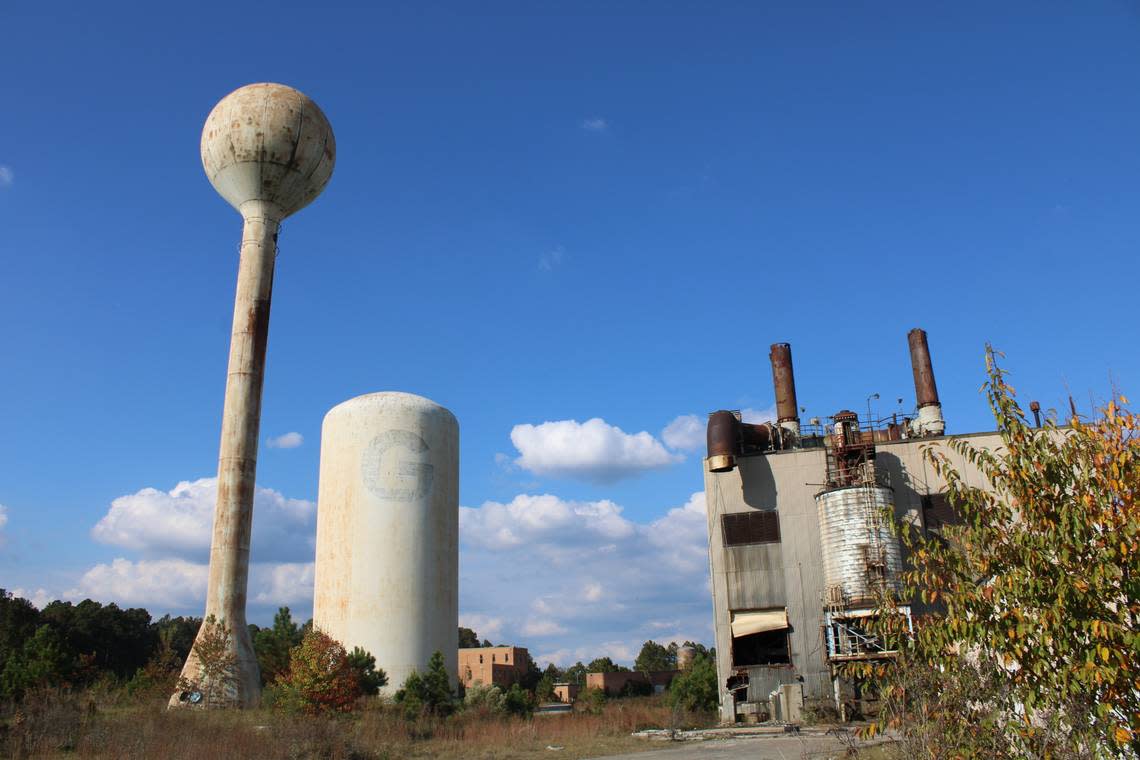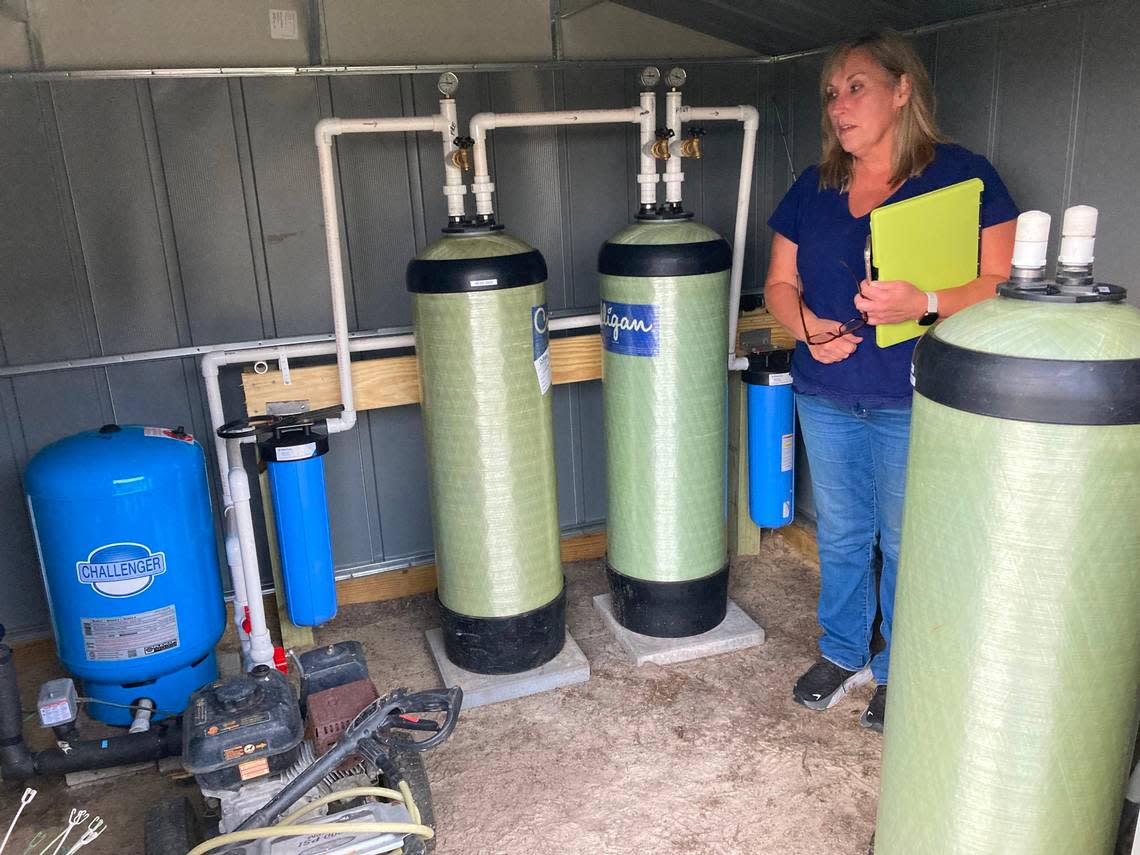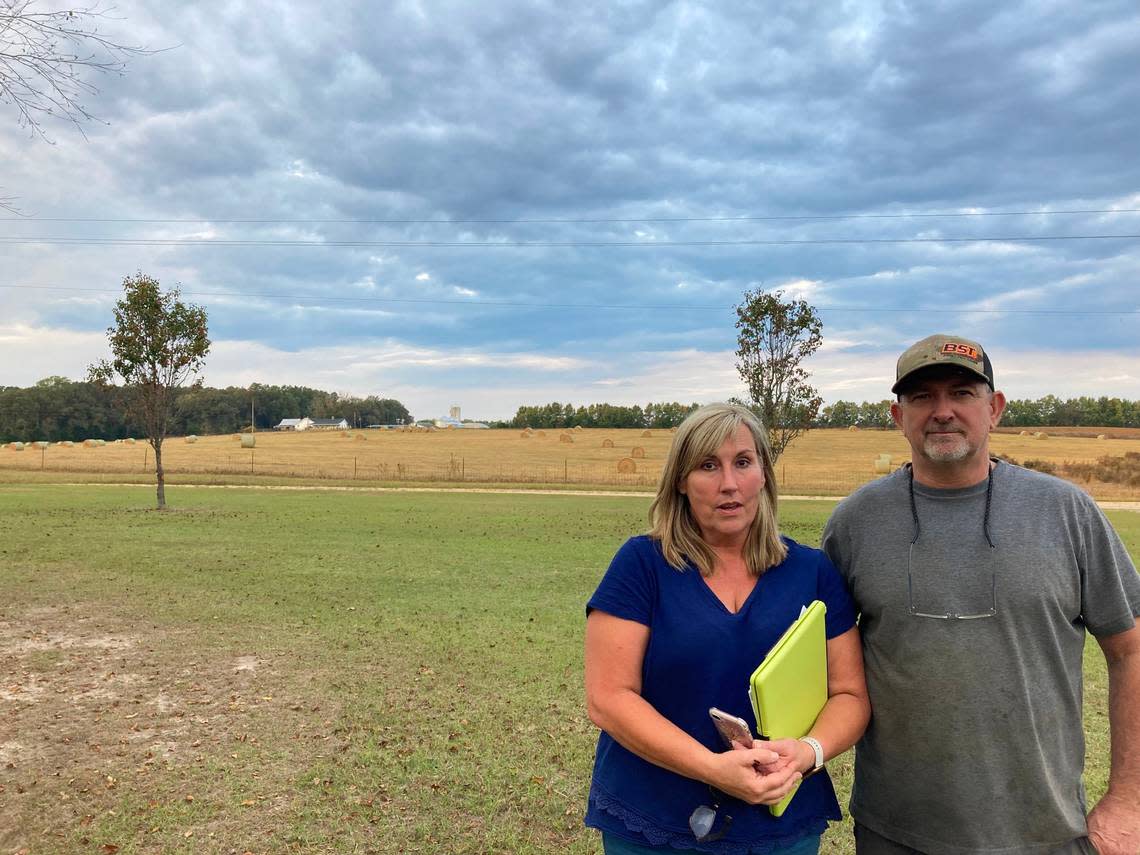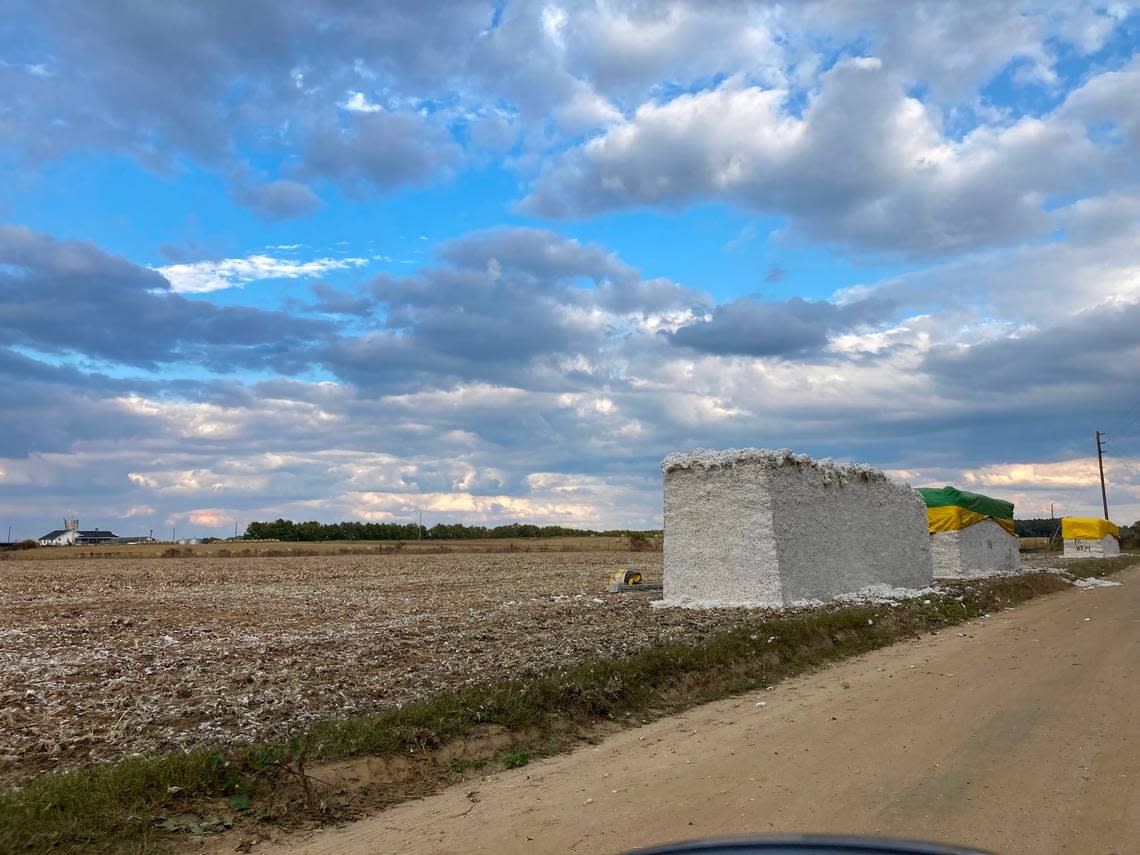SC couple says tainted fertilizer poisoned well. They’ve sued three industrial giants
A South Carolina couple whose backyard well was contaminated by industrial chemicals has taken three corporate giants to court, alleging that the companies are responsible for pollution that worked its way into the family’s drinking water.
Jamie and Kim Weatherford, who live in rural Darlington County, are suing the E.I. DuPont de Nemours, 3M and Chemours corporations for damages in a case that could cost the companies millions of dollars.
The Weatherfords say a textile mill in the town of Society Hill provided industrial sludge to farmers for use as a fertilizer, but the sludge was polluted with “forever chemicals’’ that the big industries had supplied to the mill.
The chemicals then seeped from farm fields into the groundwater that feeds the Weatherfords’ well, they say. DuPont, Chemours and 3M knew, or should have known, the chemicals were toxic and would leak into groundwater, the suit says.
Forever chemicals are of increasing concern nationally because they don’t break down easily in the environment and are tied to an array of illnesses, including cancer.
Vincent Sheheen, a Camden lawyer representing the Weatherfords, said the lawsuit is intended to help the Weatherfords and others whose land has been devalued or their drinking water ruined by pollution that seeped out of the sludge.
“We have families who now have their wells, their property, their family homes contaminated by these forever chemicals, that just like the name says, are never going away,’’ Sheheen said. “If you think about who should bear that cost, it should not be the innocent property owners, it should be the people and the companies that made billions of dollars off these chemicals.’’
Waste sludge generated at the Galey and Lord textile plant was put on more than 300 farm fields covering nearly 10,000 acres, the U.S. Environmental Protection Agency says. Much of it was applied in Darlington, Chesterfield and Marlboro counties, the EPA says. The sludge, a mushy gunk created by the textile manufacturing process, was allegedly used as a fertilizer over a 20-year period, beginning in 1993.
Galey and Lord’s textile plant was abandoned in 2016 and has since been declared a federal Superfund site, meaning it is on a priority list for cleanup because of substantial pollution. Sediment in the Great Pee Dee River and wetlands near the plant were contaminated with forever chemicals, known formally as per- and poly-fluoroalkyl substances, or PFAS, according to the federal government.
In legal filings, lawyers for DuPont, Chemours and 3M say the industries are being blamed for a problem caused by the Galey and Lord textile plant, and the lawsuit should be tossed out of court.
The case against the industries “is devoid of plausible, factual allegations (and) silent as to the real alleged wrongdoers here — the owners and operators of the G&L facility,’’ attorneys for the industries wrote in a Sept. 9 legal filing.
A spokesman for 3M said in an email Thursday that the company “acted responsibly in connection with products containing PFAS and will vigorously defend its record of environmental stewardship.’’
Efforts to reach spokespeople for DuPont and Chemours were not successful.

Galey and Lord was not named in the federal lawsuit, but a separate lawsuit filed Nov. 3 in state court names the textile company and its former parent, Burlington Industries. The state suit also was filed by the Weatherfords.
They are seeking compensation for “significant damages,’’ including the cost of filtering polluted water and air, replacing plumbing fixtures and appliances, and a reduced value to their property.
Galey and Lord and Burlington at one time filed for bankruptcy, but some compensation could be available as they emerge from the proceedings, attorneys said. Efforts to locate someone to speak for the companies were unsuccessful last week.
Desperate family
Kim Weatherford, 53, said she and her husband didn’t want to take legal action but believed it was the only way to protect their drinking water, property values and health.
They depend on well water for showers, drinking water and cooking at their home, a modest structure set back from a dirt road between Society Hill and Hartsville in eastern South Carolina. The family well sits inside a small backyard building that now contains three large tanks as part of the water filtering system.
The Weatherfords have lived in the house on Journeys End Road with their son for more than a decade. Jamie Weatherford owns a small business that builds racing cars. Kim Weatherford works at a local concrete company. She has spoken at the state Legislature about the need to control PFAS contamination across South Carolina.
“A lawsuit is the very last thing you want to get involved in, but how else do you go up against something this big?’’ she asked, as she reflected last week on her family’s challenges with contaminated drinking water.
While the federal government has installed filters on her well, they must be periodically serviced, and she’s concerned that the filters are not always effective. She worries about how past PFAS pollution has impacted her college-age son, who has a health condition. She also wonders whether PFAS contributed to the death of a family dog that chewed part of a used PFAS water filter that had been changed out.
Forever chemicals once were used heavily by the textile industry to make stain-and-water-resistant clothing and carpeting, among other things. They also were used to make nonstick frying pans and in foams used by firefighters.
The chemicals, however, are of increasing concern. They have been tied to a number of ailments that can result when people drink water or eat food contaminated with PFAS compounds over time. Among those is decreased fertility in women and developmental delays in children, as well as increased risk of prostate and kidney cancer, according to the U.S. Environmental Protection Agency, which says research into the health impacts still is ongoing.
Kim Weatherford’s well, at one point, registered one type of PFAS pollution at 120 parts per trillion, substantially higher than a federal health advisory limit of 70 parts per trillion. Her mother-in-law’s PFAS readings were even higher, The State reported last year. Follow-up tests indicated higher levels of the forever-chemical pollution.

All told, 46 of the 103 wells tested in the area for PFAS showed some level of contamination. Of that, 23 wells had levels above the 70 standard. Another 23 showed PFAS below the 70 health advisory level, state regulators say.
Meanwhile, since last year’s findings, the federal government has lowered the health advisory limit from 70 parts per trillion to near zero for two of the PFAS compounds of most concern. The government is now working on an enforceable maximum contaminant level, which may be less than 70 parts per trillion.
So far, the government has not provided filters for some people who say their wells have PFAS pollution above the new, tighter advisory advisory level of near zero.
The current PFAS problem near the Galey and Lord sludge fields could be resolved with the extension of county water lines, but even if that happens, people who were exposed for years worry about lingering health effects.
The federal lawsuit, which says claims exceed $5 million, said DuPont employees expressed concerns about PFAS as early as 1954 and that the company learned more through the years about the hazards. But DuPont was not forthcoming with government regulators about the danger, the suit said. The suit said 3M began producing one type of PFAS as early as 1947. Four years later, DuPont began purchasing the material from 3M to use in the production of Teflon, the suit said.
DuPont paid $16.5 million in 2004 to settle a case in which the EPA charged that the company violated the law by withholding information about the release of PFAS in West Virginia, The New York Times reported.
Powerful companies
Success of the Weatherfords’ lawsuits is far from decided. Both the federal and state suits are seeking class action status that could involve claims by hundreds of other people whose land and water may have been affected by PFAS-tainted sludge. But a judge has not yet approved class status.
In recent federal court filings, DuPont, Chemours and 3M asked a judge to dismiss that case.
“Merely alleging that a defendant supplied chemicals to a manufacturing facility does not constitute an ultrahazardous activity in South Carolina,’’ the DuPont, Chemours and 3M lawyers wrote in a September court filing.
While the case has a long way to go, it may come as no surprise to those who’ve encountered chemical pollution in their drinking water or who have otherwise been affected. The case is among an avalanche of lawsuits filed nationally since 2005 over PFAS, according to research conducted by Bloomberg.

Bloomberg found that E.I. du Pont de Nemours was a defendant in more than 6,100 PFAS lawsuits in the past 17 years. In recent years, 3M also has experienced an increasing number of lawsuits over PFAS, Bloomberg reported.
The Weatherfords’ lawyers say, unlike many cases nationally, the one they have filed looks at how toxins in sludge affected the environment.
The companies sued by the Weatherfords are economic heavyweights with long histories of production.
DuPont, founded in 1802 and incorporated in 1899, has made a variety of products through the years, but it has been considered a leader in the manufacture of commercial polymers, according to Britannica Online Encyclopedia. DuPont reported net sales of $16.7 billion last year.
3M, which traces its roots to 1902, reports annual revenue of more than $30 billion. The company has nearly 100,000 employees. It is widely known for producing cellophane tape, masking tape and photo copiers. The company also has provided adhesives for surgical drapes and makes materials used in tamper-proof packaging, Britannica.com reports.
Chemours, a company spun off by DuPont, is like DuPont among the country’s top chemical manufacturers. It provides industrial and specialty products, including coatings, plastics, refrigeration, air conditioning, transportation, semiconductors and consumer electronics, the company reports. Among the products it makes are Freon and Teflon, the material used to prevent sticking in frying pans.
Chemours reported generating $6.3 billion in revenue in 2021.

